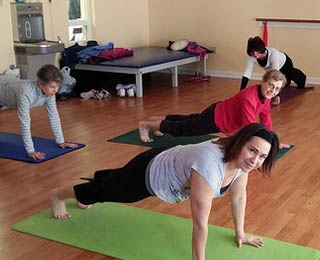Published: October 25, 2016
 Grab a hula hoop and head outside.
Grab a hula hoop and head outside.
Or
Find a place where you and a friend can swing a table tennis paddle.
Or
Lace up your tap shoes and sign up for a dancing class.
Or
Come up with your own activity to get your body moving and keep it physically healthy.
Make it Fun
We all can point to someone – maybe the face in the mirror - who hates to exercise.
But the person might love to walk through a park at daybreak or dance the night away.
That’s exercise too, and picking an enjoyable activity is key to achieving a healthy outcome.
“If your workout is unpleasant or makes you feel clumsy or inept, you’re unlikely to stick with it. Don’t choose activities like running or lifting weights at the gym just because you think that’s what you should do. Instead, pick activities that fit your lifestyle, abilities, and taste,” according to HelpGuide.Org.
Also, decide if you want a solo or a social experience. Assuming you like to run, bike or practice yoga, do you prefer following just your schedule, pace and destination, or would a class or club enhance your activity? Maybe you just need a best buddy to join you.
If mainstream physical exercise activities like running, swimming and lifting weights are not to your liking, this post will help you think “outside the box.” As always, check with your doctor before beginning a new exercise program, especially if you have physical ailments or general health concerns.
Hoops, Ropes & Paddles
Many of us remember the flimsy, inexpensive hula hoops we played with as children. Now you can buy larger and heavier hula hoops that are easier to spin, but still get you moving in the right direction.
“Hula hooping can provide similar results as other types of aerobic activities such as dancing — including salsa, hula, belly and swing dancing. An average woman can burn about 165 calories in 30 minutes of hula hooping, and an average man can burn about 200 calories in 30 minutes of hula hooping,” according to the Mayo Clinic.
You can find weighted hoops, which start at around $25, instructional CDs and free videos online, or attend a hula hoop retreat.
Jumping rope is another childhood favorite. Assuming your knees, hips and other body parts are in good shape, jumping rope can be a cheap and simple activity to do. All you need is a rope (a beaded one is recommended for novices), properly fitted athletic shoes and adequate space on a wood floor or mat.
"It's certainly good for the heart,” says Peter Schulman, MD, associate professor, Cardiology/Pulmonary Medicine, University of Connecticut Health Center in Farmington. "It strengthens the upper and lower body and burns a lot of calories in a short time, but other considerations will determine if it's appropriate for an individual."
And finally, nostalgic for your ping pong paddle?
Finding a table isn’t quite as easy as it was when most every basement was furnished with one.
Kendal at Oberlin residents, though, don’t have to travel far to play. Three days a week, Kendal’s auditorium sounds like a family room of the past. There is the ping of balls bouncing across a table, a cheer from a player when a hit is good – and groan when it isn’t – and friendly banter back and forth.
“For me it is a distraction from the woes of the world, and it’s a healthy distraction,” says Sidney Rosenfeld, who elevated table tennis from a pastime to a fun, semi-competitive sport when he moved to Kendal in 2007.
Table tennis (don’t you dare call it “ping pong”) offers many health benefits for older adults, from increased energy and focus to improved balance and mobility. “A Japanese study has shown that it slows the progression of dementia,” Sidney says. He and others have witnessed this positive effect at Kendal.
Residents in wheelchairs also join in the fun activity.
“It is a very joyful thing. My daughter came one day to watch and said, ‘I can’t believe what you’re doing and what this is doing for me,’ ” says Janet Wanyek, who uses an electric wheelchair.
Shelia Eckstein recently resumed play after being sidelined for hip surgery. “I feel invigorated after an hour,” she says.
As Jerry Berner explains, “It keeps us feeling a lot younger than our chronological age.”
The number of players varies, but the core group is made up of about a dozen men and women. Players bring their own paddle, and they help set up the three tables and a fence for ball control. The score counts less than the camaraderie. They play for about 20 minutes, and then take a break so others can play and help retrieve balls with a scoop net.
Residents have an annual tournament, and once a year, professional players from the area visit Kendal for a demonstration exhibition. Players are always looking for new ways to pursue their enthusiasm for table tennis, and new people to join in the fun.
Toe-Heel, Toe-Heel
Also at Kendal is a tap dancing class, which is held twice a week. Tap dancing helps residents improve balance, and core and lower body strength.
“We have an 85-year-old resident who struggled with balance. It was hard for him to pick up one leg. Now he is stable and able to do those things, and continues to get stronger,” says Saun Howard, fitness instructor.
Tap dancing also improves memory because dancers have to remember a sequence of steps as they dance. The dancers also perform at the annual Spring Fling.
Kendal’s swimming pool was closed for re-tiling this spring, and the fitness department decided to fill the void with a second tap dancing class. They called it “lower extremity strength and balance” for fear its real name – chair tap dancing – might discourage participation.
Not only did residents join in, but they reaped physical benefits. Saun tested the participants before and after the 6-week session to see how long they could stand on one leg. “Most everyone doubled their time, and one person quadrupled her time,” Saun says.
A chair tap dancing class will soon be added to the permanent schedule.
Moving Slowly and Mindfully
Yoga offers many physical and mental health benefits, and today’s practitioner has many different types of yoga available.
For people 50 and over the benefits include:
- Slows bone thinning, which reduces the risk of osteoporosis;
- Lubricates joints, which reduces arthritis;
- Improves balance, which reduces fall.
Tai Chi offers slow, mindful movement too.
“Tai Chi is repetitive, but it can be somewhat challenging to learn,” says Kendal Wellness Coordinator Jill Connone. “Once you have the muscle memory down, it is time to start on the meditation part of it.”
Tai Chi calms your mind and centers your energy, and helps relieve built up tension and stress. There are also physical benefits of the practice. All the movements are designed to improve the flow of chi—or energy—in the body.
“The two main aspects of Tai Chi that are brought out are balance and coordination, plus strength because you are moving very slowly,” Connone says. “Most of those in my class have felt that the largest improvement is in their balance since they are moving slowly and shifting weight.”
Of course, many of us have hobbies and daily chores that give us a physical boost, too. Gardening, bird watching, volunteering with school-age children and walking the dog are all good ways to stay in physical shape too.
And if you enjoy tracking your progress and setting goals, consider buying a Fitbit or other fitness tracker, now available just about everywhere. Then again, such a tracker might just squelch the fun for you.
 Molly Kavanaugh frequently wrote about Kendal at Oberlin for the Cleveland Plain Dealer, where she was a reporter for 16 years.
Molly Kavanaugh frequently wrote about Kendal at Oberlin for the Cleveland Plain Dealer, where she was a reporter for 16 years.





